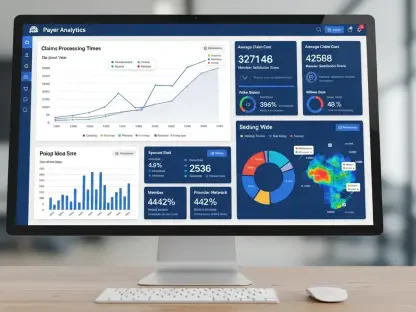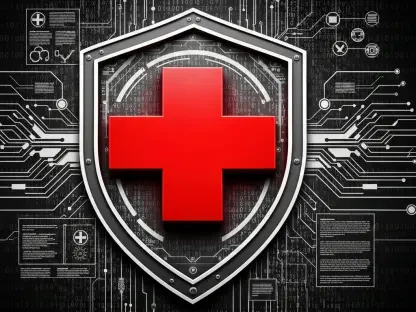Overview of Healthcare Interactive and the Industry Context
Imagine a world where a single breach of digital security can expose the most intimate details of millions of lives, from medical histories to personal identifiers, shaking trust in an entire industry. This scenario became reality for Healthcare Interactive, Inc. (HCIactive), a prominent health and incentive management platform provider based in Ellicott City, Maryland. HCIactive plays a pivotal role in the healthcare technology sector by facilitating seamless connections between healthcare providers and clients through innovative digital solutions. Its platforms manage sensitive data critical to health services, positioning the company as a key player in a rapidly evolving field where data security is paramount.
The healthcare technology industry itself stands at a crossroads of innovation and vulnerability. With major players like Epic Systems, Cerner, and now HCIactive driving advancements, the sector is increasingly reliant on digital platforms to streamline operations and improve patient outcomes. Cloud computing and data analytics have transformed how information is stored and processed, but this reliance on technology also amplifies risks, as sensitive data becomes a prime target for cybercriminals. The industry operates under stringent regulations such as HIPAA, which mandates strict safeguards for personal health information, shaping how companies design and secure their systems.
Beyond regulatory pressures, the sector faces a growing demand for interoperability and real-time data access, pushing companies to adopt cutting-edge technologies. However, this digital expansion often outpaces the development of robust cybersecurity measures, leaving gaps that malicious actors exploit. As healthcare technology continues to integrate into everyday medical practice, the balance between innovation and security remains a critical challenge, setting the stage for incidents like the one experienced by HCIactive.
Details of the 2025 Data Breach at HCIactive
Timeline and Nature of the Incident
In a stark reminder of digital vulnerabilities, HCIactive detected suspicious activity on its computer network on July 22 of this year. A subsequent investigation revealed that an unauthorized actor had accessed and copied certain files over a span of several days, specifically between July 8 and July 12. This breach, though identified relatively quickly, exposed critical weaknesses in the company’s defenses during that window of unauthorized access.
The scope of the data potentially compromised is extensive and deeply concerning. It includes personal identifiers such as names, addresses, dates of birth, Social Security numbers, and contact details. Beyond that, health insurance information, medical records including diagnoses and lab results, and claims data like billing codes were also at risk. The breadth of this exposure underscores the gravity of the incident within a sector where data privacy is not just a legal obligation but a cornerstone of public trust.
Immediate Impact and Scope of Exposure
The immediate fallout from the breach poses significant risks to affected individuals, even without confirmed instances of data misuse. The potential for identity theft, financial fraud, and unauthorized access to personal health information creates a cloud of uncertainty for those whose data may have been exposed. While exact numbers of impacted individuals remain unclear, the variety of sensitive information involved amplifies the potential consequences.
This incident also highlights the unique dangers within the healthcare context, where exposed data can have life-altering implications beyond mere financial loss. Medical information, if misused, could lead to discrimination or personal harm, making the stakes extraordinarily high. The breach serves as a wake-up call to the industry about the urgent need for airtight security protocols to protect against such far-reaching impacts.
Challenges Exposed by the Data Breach
The breach at HCIactive laid bare critical vulnerabilities in its cybersecurity infrastructure, raising questions about the adequacy of existing safeguards. Whether due to outdated systems, insufficient monitoring, or human error, the incident suggests gaps that allowed unauthorized access to persist undetected for days. Such weaknesses are not unique to one company but reflect a broader struggle within the sector to keep pace with evolving threats.
Healthcare data remains a high-value target on the black market, driving increasingly sophisticated cyberattacks. Criminals recognize the potential for profit through ransomware, identity theft, or selling medical records, making the industry a constant battleground for security experts. This reality demands a shift toward proactive measures, including real-time threat detection and robust encryption, to stay ahead of malicious actors.
Addressing these challenges requires a multifaceted approach. Investment in advanced security technologies, such as intrusion detection systems and blockchain for data integrity, could fortify defenses. Additionally, fostering a culture of cybersecurity awareness among employees and stakeholders is essential to minimize risks. The incident at HCIactive underscores that reactive measures alone are insufficient in an era of relentless digital threats.
Regulatory Response and Compliance Measures
Navigating the aftermath of a data breach in healthcare involves strict adherence to regulatory frameworks like HIPAA, which sets federal standards for protecting personal health information. State-level data breach notification laws further compel companies to act swiftly in informing affected parties and authorities. These regulations create a structured response mechanism to mitigate harm and ensure accountability.
HCIactive demonstrated compliance by promptly notifying state and federal regulators about the breach, alongside efforts to inform affected individuals. This transparency aligns with legal mandates and reflects a commitment to maintaining trust despite the setback. The company’s actions set an example of how regulatory adherence can guide crisis management in high-stakes environments.
In response to the incident, HCIactive has implemented enhanced security policies to prevent recurrence, a move that mirrors an industry-wide push for stricter data protection standards. This trend toward heightened scrutiny and enforcement is likely to shape how companies allocate resources for cybersecurity. Regulatory bodies may also tighten requirements in the coming years, from this year to 2027, to address the growing complexity of digital threats in healthcare.
Future Implications for Healthcare Technology Security
The breach at HCIactive is poised to influence cybersecurity strategies across the healthcare technology sector, prompting a deeper integration of cutting-edge tools like AI-driven threat detection. Such technologies can analyze patterns and flag anomalies in real time, offering a proactive defense against intrusions. This shift signals a broader recognition that traditional security measures must evolve to match the sophistication of modern cyberattacks.
Consumer demand for transparency and robust data protection is another market disruptor emerging from such incidents. Patients and clients are increasingly vocal about their expectations for companies to safeguard their information, potentially driving competition based on security credentials. This pressure could spur innovation in user-friendly privacy tools and clearer communication about data handling practices.
Looking ahead, global cybersecurity trends and regulatory evolution will play significant roles in shaping the industry’s approach. Collaboration across borders to combat cybercrime, alongside advancements in secure data-sharing protocols, may redefine standards. The incident at HCIactive serves as a catalyst for these changes, urging stakeholders to prioritize resilience and adaptability in an interconnected digital landscape.
Key Takeaways and Recommendations
The data breach at HCIactive reveals critical insights into the state of cybersecurity within healthcare technology. The incident, characterized by unauthorized access to a wide range of sensitive data, exposed systemic vulnerabilities while highlighting the company’s efforts to respond through securing systems, notifications, and enhanced policies. It also underscores the broader industry challenge of balancing innovation with the imperative of data protection.
For healthcare technology companies, several recommendations emerge from this event. Investing in comprehensive cybersecurity training for staff can reduce human error, a common entry point for breaches. Adopting multilayered security systems, including encryption and continuous monitoring, is vital to deter threats. Transparency with affected individuals, through timely updates and support services, remains a cornerstone of rebuilding trust.
Reflecting on the breach, the industry faces a pivotal moment to reassess its defenses and commit to stronger safeguards. The response from HCIactive paves the way for actionable steps, such as leveraging advanced technologies and fostering regulatory partnerships. Moving forward, stakeholders must prioritize a unified effort to enhance data security, ensuring that trust and resilience become the foundation of healthcare technology’s future.









